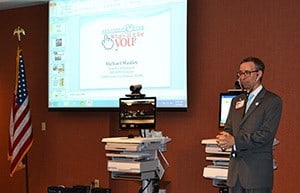Seminars Show Public What E-Link Network Makes Possible
June 21, 2013 | Now that the Arkansas e-Link high-speed broadband network is connecting all 75 counties of the state, project leaders have started teaching the public how to use it. Arkansas e-Link, led by the University of Arkansas for Medical Sciences (UAMS), is using high-speed data transmission lines to connect 454 higher education and health care institutions for videoconferencing abilities. “I think of it like the rural electrification program in the 1940s and 1950s,” said Ed Franklin, president of the Arkansas Association of Two-Year Colleges. “You not only had to deliver electricity to them, but you had to teach them how to use it so they really can see what the possibilities are.” Decades ago, some relatives of Franklin’s, who lived in rural Arkansas, were given an electric stove but used it for storing wood for their wood-burning stove because no one had shown them what it could do for them. To make sure nothing like that happens to the $128 million public investment in e-Link, a series of free public seminars about the broadband network was held at different locations throughout state. The series concluded June 7 with the final seminar at Pulaski Technical College in North Little Rock. Community and civic leaders, business leaders, educators, physicians and staff, hospital administrators and other health care providers in the state’s different regions saw demonstrations of how e-Link works, learned about educational enhancements at two-year colleges in Arkansas and heard examples of successful telehealth programs operating through e-Link. “It was great to have the chance to talk to the public about what a great communications resource e-Link is,” said Debbie Green, Arkansas e-Link project director. “The feedback was positive and enthusiastic, but the conclusion of the seminars is only the first phase of educating community leaders, educators and health care professionals as well as the general public about the network.” At the state’s two-year colleges, e-Link will serve as a vital part of distance learning and collaboration as well as a tool for economic development, Franklin said. Before e-Link, most campuses had reached the limit of their broadband capacity and were transferring data at 6-10 megabits per second. Then e-Link expanded that to 100 megabits per second and is making many more learning opportunities possible. “We had demand, but we were not able to supply bandwidth to meet it,” Franklin said. The broadband network also is connecting two-year colleges to employers whose employees need training in the workplace. Being able to do that means the colleges can better the 2,000 businesses and 50,000 workers it trains annually. That’s a convenience that saves businesses time otherwise lost in commuting and is an asset in attracting new employers “With the widespread adoption of wireless networks, smart phones and tablets, students increasingly have access to the Internet, we’re coming up with new ideas for the delivery of information and education via connectivity,” Franklin said. High-speed connections via e-Link are even more numerous in the telehealth component of the network. More than 400 of the 454 sites link health care providers. “E-Link is not only helping the ANGELS program, but it’s helping the entire state of Arkansas as far as access goes,” said Rosalyn Perkins, APN, director of Telemedicine Clinical Services at the UAMS Center for Distance Health ANGELS Program. “It’s the key with e-Link.” The ANGELS (Antenatal and Neonatal Guidelines, Education and Learning System) broadband network allows patients, local physicians and UAMS physicians to talk, see each other through videoconferencing and read ultrasound images in real time. About 495 interactive video carts with high-definition monitors and other network equipment are at multiple, diverse locations from hospitals and clinics to UAMS regional centers, health departments and community health centers. TeleHealth training has been provided by the Center for Distance Health’s South Central Telehealth Resource Center at more than 400 sites in Arkansas with a combination of face-to-face, live interactive and webcasts. Among those sites, more than 1,000 people attended trainings. Online modules, videos, webinars, and conferences are also used for training. Recently, an ANGELS patient in southeast Arkansas couldn’t drive to Pine Bluff for a videoconference consultation, Perkins said. Although it wasn’t an official site for the program, ANGELS professionals were able to find a community health center near her that recently had joined e-Link. Trained staff at the center was able and willing to help the patient make the necessary connection there through the larger network. Arkansas e-Link was created from a $102 million grant awarded in August 2010 to UAMS and partner institutions through the Broadband Technology Opportunities Program Comprehensive Community Infrastructure grant. With another $26 million in matching funds from partner institutions statewide, the project is integrating isolated community institutions to expand the capabilities and geographic reach of broadband networks serving Arkansas. |

